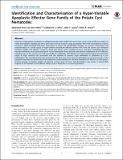Identification and characterisation of a hyper-variable apoplastic effector gene family of the potato cyst nematodes
Abstract
Sedentary endoparasitic nematodes are obligate biotrophs that modify host root tissues, using a suite of effector proteins to create and maintain a feeding site that is their sole source of nutrition. Using assumptions about the characteristics of genes involved in plant-nematode biotrophic interactions to inform the identification strategy, we provide a description and characterisation of a novel group of hyper-variable extracellular effectors termed HYP, from the potato cyst nematode Globodera pallida. HYP effectors comprise a large gene family, with a modular structure, and have unparalleled diversity between individuals of the same population: no two nematodes tested had the same genetic complement of HYP effectors. Individuals vary in the number, size, and type of effector subfamilies. HYP effectors are expressed throughout the biotrophic stages in large secretory cells associated with the amphids of parasitic stage nematodes as confirmed by in situ hybridisation. The encoded proteins are secreted into the host roots where they are detectable by immunochemistry in the apoplasm, between the anterior end of the nematode and the feeding site. We have identified HYP effectors in three genera of plant parasitic nematodes capable of infecting a broad range of mono-and dicotyledon crop species. In planta RNAi targeted to all members of the effector family causes a reduction in successful parasitism.
Citation
Eves-van den Akker , S , Lilley , C J , Jones , J T & Urwin , P E 2014 , ' Identification and characterisation of a hyper-variable apoplastic effector gene family of the potato cyst nematodes ' , PLoS Pathogens , vol. 10 , no. 9 , e1004391 . https://doi.org/10.1371/journal.ppat.1004391
Publication
PLoS Pathogens
Status
Peer reviewed
ISSN
1553-7366Type
Journal article
Description
Date of Acceptance: 11/08/2014Collections
Items in the St Andrews Research Repository are protected by copyright, with all rights reserved, unless otherwise indicated.

